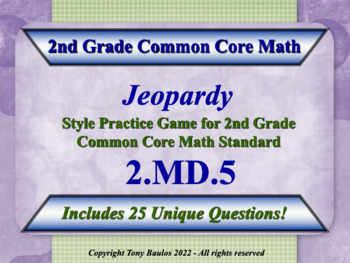2.MD.5 2nd Grade Math Jeopardy - Addition & Subtraction Word Problems w/ Google
- Zip
- Google Apps™

Description
Second Grade Common Core Math Jeopardy Game - 2 MD.5 Addition and Subtraction to Solve Word Problems 2.MD.5 Practice provides two ways for students to practice addition and subtraction within 100 to solve word problems involving lengths.
Jeopardy board includes 25 distinct problems and utilizes hyperlinks to award/deduct money from your student teams! (79 slides in all!) Board is automatically updated to show which questions have already been utilized. Also includes an Answer Key if you wish to use questions as Quiz/Test. The PowerPoint file can be used on computers, or Promethean and Smart boards.
Now includes a Google Slides TM version in addition to the original PowerPoint!
Take a look at the preview file and buy today for your students benefit!
Standard 2.MD.5 Relate addition and subtraction to length.
5. Use addition and subtraction within 100 to solve word problems involving lengths that are given in the same units, e.g., by using drawings (such as drawings of rulers) and equations with a symbol for the unknown number to represent the problem.





